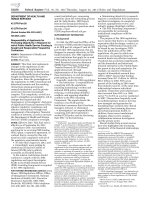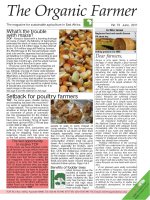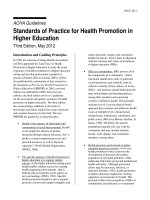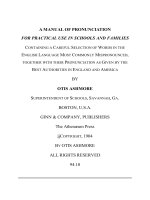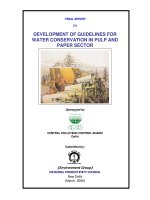Optimum extraction of groundwater for sustainable use in watershed areas
Bạn đang xem bản rút gọn của tài liệu. Xem và tải ngay bản đầy đủ của tài liệu tại đây (89.61 KB, 8 trang )
Int.J.Curr.Microbiol.App.Sci (2019) 8(10): 1549-1556
International Journal of Current Microbiology and Applied Sciences
ISSN: 2319-7706 Volume 8 Number 10 (2019)
Journal homepage:
Original Research Article
/>
Optimum Extraction of Groundwater for Sustainable Use
in Watershed Areas
Vaishnavi1*, G. B. Lokesh1, T. J. Amrutha1, Jagrati B. Deshmanya1
and G. V. Srinivasa Reddy2
1
Department of Agricultural Economics, 2Department of Soil and Water Engineering,
University of Agricultural Sciences, Raichur, 584104, India
*Corresponding author
ABSTRACT
Keywords
Groundwater,
Watershed,
Optimum
extraction,
Sustainable
management
Article Info
Accepted:
12 September 2019
Available Online:
10 October 2019
The present study was undertaken to analyze the optimum extraction of groundwater in
watershed areas for sustainable use. There was lack of efficient irrigation facility is the
major cause for low agricultural productivity in Karnataka due to its over exploitation is
leading to continuous decline in the groundwater table. The study was followed purposive
random sampling for selection of micro-watersheds and based on the primary data all
groundwater irrigated farmers of respective micro-watershed areas were interviewed. A
sensitive analysis was carried out to know the groundwater used for optimal as well as
sustainable patterns of groundwater management. The results showed that in study area,
cropping intensity of Kavalakeri-4 and Ryavanki-1 micro-watershed area was about
160.25 and 157.52 per cent respectively. And Chattar-1 and Kumarkhed micro-watershed
area was about 148.45 and 118.48 per cent respectively. The optimal groundwater usage
for major crops showed that there was higher groundwater usage than required in crops
like chilli, sugarcane, maize in micro-watershed areas of Koppal and redgram, onion, bajra
in micro-watershed areas of Raichur district. By optimizing the existing water usage for
major crops can reduce the overuse of groundwater indicating the sustainable management
of groundwater in micro-watershed areas. Strategies for groundwater usage and optimum
extraction must be based on adoption of cropping pattern, modern irrigation approach,
rainfall and other agro climatic conditions for sustainable use of groundwater to improve
livelihood of the farmers. Hence the government policy needs to be oriented towards these
to motivate farmers to adopt micro (drip & sprinkler) irrigation. In addition, it is essential
to promote irrigation literacy to enable farmers to use water efficiently.
Introduction
Land and water resources are the basic
resources for agriculture and it plays an
important role in shaping the economic
development of the country. The demands for
1549
Int.J.Curr.Microbiol.App.Sci (2019) 8(10): 1549-1556
these resources are continuously increasing
with the rising population. Agriculture is the
predominant sector that enhances rural
livelihood for nearly 60 per cent of the rural
population. There are seven river systems in
the State viz., Krishna, Cauvery, Godavari,
West Flowing Rivers, North Pennar, South
Pennar and Palar. Utilization of water in the
West Flowing Rivers is hampered due to
difficulties in construction of large storage
reservoirs. Yield in the seven river basins is
estimated as 3,418 TMC at 50 per cent
dependability and 2,934 TMC at 75 per cent
dependability. The economically utilizable
water for irrigation is estimated at 1,695 TMC
(Chandrakanth, 2009).
Water policies focus relatively on the demand
side of water (Million wells scheme, subsidy
for micro irrigation, conveyance pipes, energy
subsidy) neglecting the supply side of water
(or lack of efforts towards recharging well)
affecting its sustainable use. Use of
groundwater in optimum levels is most
important among all resources. This study will
help to know the changing groundwater use
pattern in agriculture and its impact on
livelihood of farmers. In H-K region, in this
context, the present study is carried out with
the following specific objective, to estimate
the optimum extraction of groundwater in
watershed area for sustainable use.
Materials and Methods
Groundwater is another important source for
meeting nearly half of the demand for
irrigation, industrial production and municipal
water needs of both rural and urban areas in
Karnataka.
The
total
replenishable
groundwater potential for the state is estimated
at 17.03 Billion Cubic Meters (BCM) received
from both monsoon and non-monsoon seasons
(rainfall constitutes 9.48 BCM and recharge of
7.55 BCM from other sources). It is estimated
that 2.2 BCM of water is naturally discharged
during the non-monsoon period and net
availability of groundwater is 14.81 BCM.
The total annual groundwater draft (9.41
BCM) for irrigation and domestic and
industrial use is estimated at 8.59 and 0.28
BCM respectively. Karnataka has already over
drafted groundwater by 64 per cent and 6.53
BCM is available for future use (Anon., 2014).
Groundwater usage and its development is
also controlled by the socio-economic
conditions of the farmers apart from the
technical feasibility. The factors which
determine the extinct of groundwater use are
the cropping pattern, crop water requirement,
groundwater
management,
policy
interventions in groundwater extraction and
well density. Excessive usage of groundwater
will lead to its irreversible degradation.
The study was conducted in Kavalkeri-4,
Ryavanaki-1 micro-watersheds of Koppal and
Chattar-1, Kumarkhed micro-watersheds of
Raichur district, Karnataka with purposive
random sampling method. The data were
collected from the respondent farmers during
2018-19. The farmers were interviewed
personally using a structured pre tested
schedule in each micro-watershed area. The
data pertaining to cropping pattern and
optimization of the existing water used for
major crops in each micro-watershed.
Linear programming
To obtain the optimal groundwater usage for
each crop in each micro-watershed area, the
linear programming method was used. The
objective function was to minimize
groundwater extraction for each crop grown in
each micro watershed area. The mathematical
model was of the following form:
Where,
1550
Int.J.Curr.Microbiol.App.Sci (2019) 8(10): 1549-1556
Z = Aggregate groundwater extraction from
the crops in given micro watershed
Wi = Volume of Groundwater extracted from
each ith crop (acre inch)
Xi = Crop grown under each micro watershed
area
Subject to constraints
Where,
was occupied by groundnut (20.80%)
followed by chilli (6.40%), wheat (5.60%),
chickpea (4.80%) and cowpea (2.40%).
In another micro-watershed area Ryavanki-1
during kharif season major area occupied by
maize that was 26.40 per cent of total gross
cropped area followed by sunflower (16.29%),
sugarcane (11.24%), vegetables (8.43%), bajra
(3.37%), cotton and redgram (1.69%) and
during rabi season major area occupied by
groundnut (9.55%) of total gross cropped area
followed by chickpea (6.18%), chilli (5.62%)
and wheat, sorghum, onion (2.81%) of total
gross cropped area and the cropping intensity
of Kayalakeri-4 and Ryavanki-1 microwatershed area was about 160.25 and 157.52
per cent respectively (Table1).
Ai = area of each crop grown
In similar way, cropping pattern followed in
Chattar-1 micro-watershed of Raichur district
was presented in Table 2. It was observed that
during kharif season major area occupied by
bajra (31.94%) followed by redgram
(28.47%), sesamum (12.50%) and vegetables
(4.86%) of total gross cropped area.
Where,
NRi = Net returns of each crop grown
Whereas in rabi season major area occupied
by chilli (6.94%), groundnut and onion
(3.47%), sorghum and cowpea (2.08%), wheat
and chickpea (1.39%) of total gross cropped
area.
Where,
Wei = Water use efficiency of each crop
grown
Results and Discussion
To meet the objective of the study, cropping
pattern followed in Kavalakeri-4 microwatershed it was seen from the Table 1 that
during kharif season major area was occupied
by maize (39.20%) of total gross cropped area
followed by sugarcane (8.00%), bajra
(5.60%), vegetables (4.00%) and redgram
(3.20%). Whereas in rabi season major area
Whereas in Kumarkhed micro-watershed area
during kharif season major gross cropped area
occupied by bajra was 37.59 per cent followed
by redgram (21.99%), sesamum (14.89%) and
vegetables (3.55%) and during rabi season
major area occupied by onion (5.67%), chilli
(4.26%), sorghum and cowpea (2.84%),
chickpea (2.13%) and groundnut (1.42%) of
total gross cropped area and the cropping
intensity of Chattar-1 and Kumarkhed microwatershed area were about 148.45 and 118.48
percent respectively (Table 2). Cropping
intensity is one of the measuring indices for
land use efficiency. The cropping intensity
1551
Int.J.Curr.Microbiol.App.Sci (2019) 8(10): 1549-1556
depends on many factors viz., natural
conditions (like rainfall and climate) and also
socio economic factors. However, given the
situation the cropping intensity of respondent
farmers was more than 100 per cent indicating
efficient utilization of land. Wherein Table 1
and Table 2 showed that most of the crops
were irrigated through groundwater because of
the availability of water throughout the year.
Optimal groundwater usage for major
crops
The analysis of optimal groundwater usage
among major crops in Kavalakeri-4 microwatershed carried out. The existing
groundwater usage for maize (11.72 ac/inches)
followed by groundnut (9.25 ac/inches), chilli
(11.15 ac/inches), sugarcane (35.94 ac/inches).
In optimal plan, groundwater usage for maize
(9.97 ac/inches) followed by groundnut (8.93
ac/inches), chilli (10.54 ac/inches), sugarcane
(35.41 ac/inches). Hence, results showed that
there was reduction of groundwater usage was
found more in maize (14.93%) followed by
chilli (5.51%), groundnut (3.46%).
Whereas in Ryavanaki-1 micro-watershed
existing groundwater usage for maize (11.77
ac/inches) followed by groundnut (9.43
ac/inches), chilli (12.01 ac/inches), sugarcane
(34.59
ac/inches).
In
optimal
plan,
groundwater usage for maize (10.56 ac/inches)
followed by groundnut (9.11 ac/inches), chilli
(11.05 ac/inches), sugarcane (34.13 ac/inches).
Hence, results showed that there was higher
reduction of groundwater usage was found for
maize (10.28%) followed by chilli (7.99%),
groundnut (3.39%) (Table 3).
In similar way optimal groundwater usage
among major crops in Chattar-1 microwatershed carried out. The existing
groundwater usage for bajra (6.48 ac/inches)
followed by redgram (7.83 ac/inches),
sesamum (11.54 ac/inches), onion (10.85
ac/inches). In optimal plan, groundwater usage
for bajra (5.88 ac/inches) followed by redgram
(6.05 ac/inches), sesamum (11.31 ac/inches),
onion (9.68 ac/inches). Hence, results showed
that there was higher reduction of groundwater
usage was found for bajra (9.25%) followed
by redgram (22.74%), sesamum (1.99%),
onion (10.78%). Whereas in Kumarkhed
micro-watershed existing groundwater usage
for bajra (6.61 ac/inches) followed by redgram
(7.74 ac/inches), sesamum (11.72 ac/inches),
onion (10.13 ac/inches). In optimal plan,
groundwater usage for bajra (6.09 ac/inches)
followed by redgram (5.13 ac/inches),
sesamum (10.78 ac/inches), onion (9.06
ac/inches). Hence, similar results were showed
that there was reduction of groundwater usage
found was more in bajra (7.87%) followed by
redgram (33.70%), sesamum (8.02%) and
onion (10.60%) (Table 4). The similar study
about optimal crop plan was carried out in
Perambalur district of Tamil Nadu by
Mahendran et al., (2006).
The results of this study shown that the
cropping pattern in micro-watershed areas
under given situation the cropping intensity of
respondent farmers was more than 100 percent
indicating efficient utilization of land.
And also the results of the optimal
groundwater usage for major crops showed
that there was higher groundwater usage in
crops like redgram, onion, bajra in microwatershed areas.
It might be due to reasons like flood irrigation
method, increase in number of hours of
pumping etc. Over utilization of groundwater
for irrigation than the optimum level due to
lack of adequate knowledge and also more
inefficiency was found among the traditional
groundwater users, which causes overexploitation of groundwater.
1552
Int.J.Curr.Microbiol.App.Sci (2019) 8(10): 1549-1556
Table.1 Cropping pattern of respondent farmers in Koppal district, 2018-19
Season
Kharif
Rabi
Annual/
perennial
crop
Crop
Redgram
Maize
Cotton
Bajra
Sunflower
Vegetables
Sugarcane
Wheat
Sorghum
Cowpea
Chickpea
Groundnut
Onion
Chilli (seed
production)
Kavalakeri-4 (MW)
(n=16)
Groundwater Rainfed
Total
Irrigated
(acre)
(acre)
4
4
45
4
49
7
7
5
5
10
10
4
3
7
3
3
4
2
6
26
26
8
8
% to gross
cropped
area
3.20
39.20
5.60
4.00
8.00
5.60
2.40
4.80
20.80
6.40
Ryavanaki-1 (MW)
(n=15)
Groundwater Rainfed
Total
Irrigated
(acre)
(acre)
3
3
32
15
47
3
3
6
6
19
10
29
15
15
20
20
5
5
5
5
6
5
11
15
2
17
5
5
10
10
% to gross
cropped
area
1.69
26.40
1.69
3.37
16.29
8.43
11.24
2.81
2.81
6.18
9.55
2.81
5.62
-
-
-
-
2
-
2
1.12
105
20
125
100.00
129
49
178
100.00
63
15
78
100.00
76
37
113
100.00
Mango
Gross
cropped area
(acres)
Net Cropped
area (acres)
Cropping
Intensity
(%)
160.25
157.52
1553
Int.J.Curr.Microbiol.App.Sci (2019) 8(10): 1549-1556
Table.2 Cropping pattern of respondent farmers in Raichur district, 2018-19
Season
Kharif
Rabi
Annual/
perennial
crop
Crop
Chattar-1 (MW)
(n=18)
Groundwater
Rainfed
Irrigated
(acre)
Total
(acre)
-
41
46
18
7
2
3
3
2
5
5
10
% to
gross
cropped
area
28.47
31.94
12.50
4.86
1.39
2.08
2.08
1.39
3.47
3.47
6.94
2
-
2
120
24
78
19
Redgram
Bajra
Sesamum
Vegetables
Wheat
Sorghum
Cowpea
Chickpea
Groundnut
Onion
Chilli (seed
production)
Guava
38
33
15
7
3
2
5
5
10
3
13
3
2
3
-
Gross
cropped area
(acres)
Net Cropped
area (acres)
Cropping
Intensity
(%)
Kumarkhed (MW)
(n=16)
Groundwater
Rainfed
Total
Irrigated
(acre)
(acre)
23
31
17
5
4
3
2
8
6
8
22
4
4
-
31
53
21
5
0
4
4
3
2
8
6
% to
gross
cropped
area
21.99
37.59
14.89
3.55
0.00
2.84
2.84
2.13
1.42
5.67
4.26
1.39
4
-
4
2.84
141
100.00
103
38
141
100.00
97
100.00
85
34
119
100.00
148.45
118.48
1554
Int.J.Curr.Microbiol.App.Sci (2019) 8(10): 1549-1556
Table.3 Optimal groundwater usage for major crops using linear programming in Koppal
district
Sl.
No.
Crop
1
2
3
Maize
Groundnut
Chilli (seed
production)
Sugarcane
Total
4
Kavalakeri-4 (MW)
Existing
Optimal
Water
groundwater groundwater
saving
usage(acre
usage (acre
(%)
inches)
inches)
11.72
9.97
14.93
9.25
8.93
3.46
11.15
10.54
5.51
35.94
68.06
35.41
64.84
Ryavanaki-1 (MW)
Existing
Optimal
groundwater groundwater
usage (acre
usage (acre
inches)
inches)
11.77
10.56
9.43
9.11
12.01
11.05
1.49
4.73
34.59
67.80
34.13
64.85
Water
saving
(%)
10.28
3.39
7.99
1.33
4.48
Table.4 Optimal groundwater usage for major crops using linear programming in Raichur
district
Sl.
No.
Crop
1
2
3
4
Bajra
Redgram
Sesamum
Onion
Total
Chattar-1 (MW)
Existing
Optimal
Water
groundwater groundwater saving (%)
usage(acre
usage (acre
inches)
inches)
6.48
5.88
9.25
7.83
6.05
22.74
11.54
11.31
1.99
10.85
9.68
10.78
36.70
32.92
10.30
And for this government need to be educated
and motivated to farmers to invest on low
water consumption technologies like drip
irrigation and sprinkler irrigation for
conservation of groundwater.
The deficiency of water resources in microwatershed areas can be overcome by
harvesting the available potential of runoff and
efficient utilization by increasing micro
irrigation techniques to the entire area and also
decreasing area of high water required crops
and modifying in cropping pattern to reduce
the groundwater decline which contributing to
sustainable groundwater management. There
is a need for planning of optimum
Kumarkhed (MW)
Existing
Optimal
groundwater groundwater
usage (acre
usage (acre
inches)
inches)
6.61
6.09
7.74
5.13
11.72
10.78
10.13
9.06
36.20
31.06
Water
saving
(%)
7.87
33.70
8.02
10.60
14.20
groundwater use in each micro-watershed of
the state based on rainfall, cropping pattern
and other agro climatic conditions for
sustainable use of groundwater to improve
livelihood of the farmers. Hence efforts should
be made to include groundwater management
as a one of the importance component in
watershed programmes.
References
Anonymous, 2014, Ministry of Water
Resources, River Development and
Ganga Rejuvenation. GOI.
Chandrakanth, M. G., 2009, Karnataka state
water sector reform: Current status,
1555
Int.J.Curr.Microbiol.App.Sci (2019) 8(10): 1549-1556
emerging issues and needed strategies.
International Water Management
Institute (IWMI).
Mahendran, R., Chandrashekaran, M. and
Gurunathan, S., 2006, A Study on
evolving optimal cropping patterns in
ground water over-exploited region of
perambalur district of Tamil Nadu.
Agricultural Economics Research
Review, 19: 95-108.
Srivastava, S. K., Kumar Ranjit. and Singh R.
P., 2009, Extent of Groundwater
extraction and irrigation efficiency on
farms under different water-market
regimes in Central Uttar Pradesh.
Agricultural Economics Research
Review, 22: 87-97.
How to cite this article:
Vaishnavi, G. B. Lokesh, T. J. Amrutha, Jagrati B. Deshmanya and Srinivasa Reddy, G. V.
2019. Optimum Extraction of Groundwater for Sustainable Use in Watershed Areas.
Int.J.Curr.Microbiol.App.Sci. 8(10): 1549-1556. doi: />
1556



